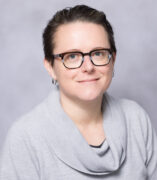
Corrinne Mills, PhD
Associate Professor
Physics
Contact
Building & Room:
2272 SES
Address:
845 West Taylor St.
Office Phone:
Email:
Related Sites:
About
Professor Mills, a member of the CMS collaboration, researches the properties of the observed Higgs boson and connections between the physics of Higgs bosons and the fundamental questions that the Standard Model of particle physics, for all its successes, cannot answer. How did the matter in our universe arise from a matter-antimatter-symmetric initial state? What is the nature of dark matter, for which there is strong observational evidence but which cannot be any known fundamental particle? Can we see evidence of new particles and interactions even beyond the kinematic reach of the LHC through their influence on observable processes? Study of the observed Higgs boson and searches for additional Higgs bosons may hold the key.
The High-Luminosity LHC, scheduled to begin operations in 2029, will let us confront these questions with an unprecedented dataset, around 20 times more integrated luminosity than has been collected to-date. The full potential of this dataset can only be realized with detectors upgraded to handle the corresponding increase in proton-proton interaction rates. To this end, Professor Mills is working on the replacement of the CMS forward pixel detector that will provide precision particle tracking and vertexing in the busy HL-LHC conditions.
Before joining UIC, Professor Mills was a senior research fellow at the University of Edinburgh and a member of the ATLAS collaboration. She led the finalization and publication of the final LHC Run-1 publications for a Higgs boson decaying to two W bosons, including the most precise single-channel measurement of the inclusive Higgs boson signal strength. Prior to that, as a postdoctoral researcher at Harvard University, she contributed to the 2012 Higgs boson discovery and the first measurements of inclusive W boson production at the LHC. As a Ph.D. student at UC Santa Barbara, she measured the top-quark pair-production cross section and studied electron identification performance using Tevatron data as a member of the CDF collaboration.
Selected Publications
- “Measurements of the Higgs boson production cross section and couplings in the WW boson pair decay channel in proton-proton collisions at √s= 13 TeV”, accepted for publication by Eur. Phys. J. C. (2022).
- “A portrait of the Higgs boson by the CMS experiment ten years after the discovery”, CMS Collaboration, Nature 607, 60-68 (2022).
- “Measurement of fiducial differential cross sections of gluon-fusion production of Higgs bosons decaying to WW*→ eνμν with the ATLAS detector at √s = 8 TeV”, ATLAS Collaboration, JHEP 2016, 104 (2016).
- “Observation and measurement of Higgs boson decays to WW*with ATLAS at the LHC”, ATLAS Collaboration, Phys. Rev. D 92, 012006 (2015).
- “Measurements of Higgs boson production and couplings in diboson final states with the ATLAS detector at the LHC”, ATLAS Collaboration, Phys. Lett. B72688 (2013).
- “Observation of a new particle in the search for the Standard Model Higgs boson with the ATLAS detector at the LHC”, ATLAS Collaboration, Phys. Lett. B 716, 1 (2012).
- “Measurement of the W → ℓν and Z/γ*→ ℓℓ production cross sections in proton-proton collisions at √s = 7 TeV with the ATLAS detector”, ATLAS Collaboration, JHEP 2010, 060 (2010).
- “A Measurement of the tt cross section in pp collisions at √s = 1.96 TeV using dilepton events with a lepton plus track selection”, CDF Collaboration, Phys. Rev. D 79, 112007 (2009).
Education
AB, Physics (2001), Harvard University
PhD, Physics (2007), University of California, Santa Barbara